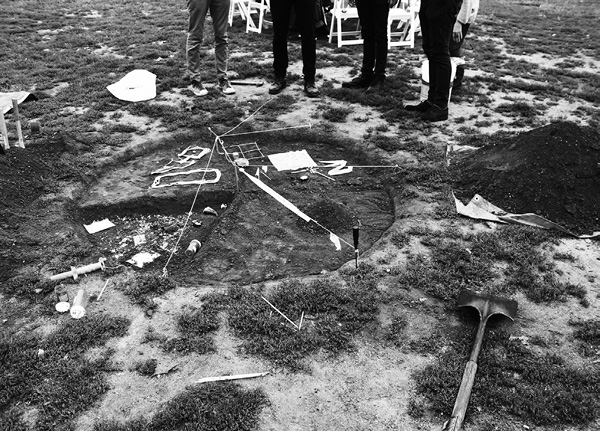
BBQUEENS
first performed on October 8, 2016
Queens Museum, Queens, NY
performed once in 2016
NANA DOMAIN / MATTHIAS NEUMANN, SCOTT SCHWARTZ, CATHERINE REHWINKEL, JEFFREY BENJAMIN, MATTHEW C. LANGE, CHRISTINE FINN, JOE BOCHYNSKI
New York, NY
703109363h703109363e703109363l703109363l703109363o703109363@703109363n703109363a703109363n703109363a703109363-703109363n703109363y703109363.703109363n703109363e703109363t
nana-ny.net
BBQUEENS
NANA DOMAIN / MATTHIAS NEUMANN, SCOTT SCHWARTZ, CATHERINE REHWINKEL, JEFFREY BENJAMIN, MATTHEW C. LANGE, CHRISTINE FINN, JOE BOCHYNSKI
As part of our contribution to the exhibition Chance Ecology at the Queens Museum, Nana Domain realized a performative installation/happening that continues a collective investigative dialogue between archeological and artistic narrative. Nana Domain is a loosely organized collective of artists and archeologists, and the collaboration transcends various disciplines with particular interest in the mechanisms of narrative creation as witnessed in the processes of archaeology and artistic creation, enacted with the tool set of the archeologist.
“BBQueens” created an inverse archeological site in front of the Queens Museum in New York City. The work enacted a BBQ on the lawn across the entrance to the museum with the formal set up of two fixed elements: a table with chairs for participants in the BBQ, and a shallow pit excavation mimicking the diameter dimension of the Westinghouse Time Capsule to the south of the museum. The circular pit was excavated in a meticulous archeological fashion prior to having a BBQ next to the archeological pit. Thereafter, remnants from the BBQ and objects brought by the participants with charged but fictitious narratives were left in the hole arranged for posterity before closing the hole again. There is now a potential future enigmatic archeological site in front of the museum that in the unlikely but hopeful event of a future archeological excursion in or around present day Corona Park will bear witness to the event. And if that future archeologist will stumble upon the circular pit of artifacts he or she will undoubtedly get it wrong. Whatever meaning will be imbued to the objects discovered the most unlikely explanation will be that someone in the distant past buried the objects just so they could be found by some future archeologist as a self-referential loop. Any such interpretation would have to be classified as a conspiracy theory. As such our project elevates the notion of conspiracy theory into the realm of veracity, at least in the unlikely event that someone in the future should be bold enough to suggest that what happened actually happened.